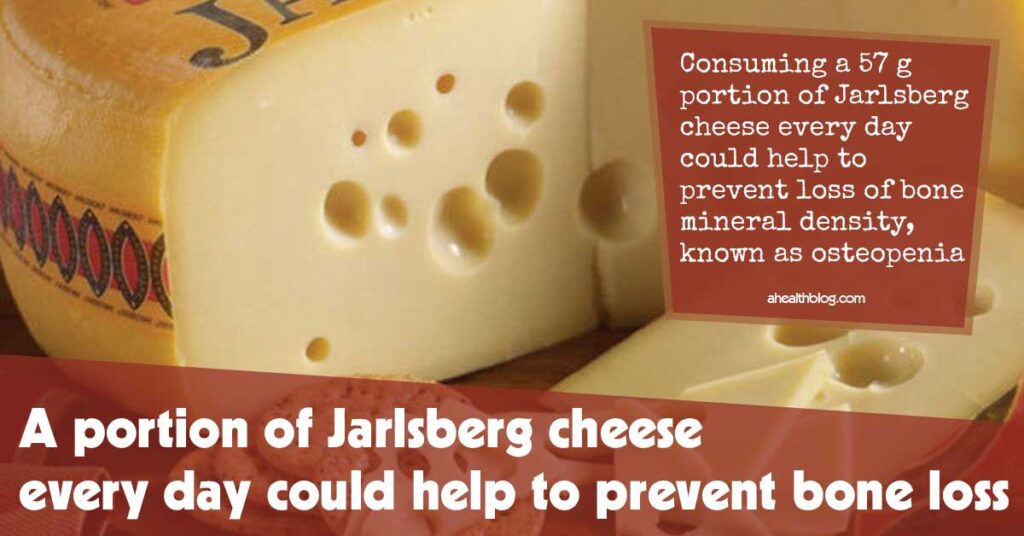Daily Consumption of Jarlsberg Cheese May Aid in Preventing Bone Loss
An intriguing study suggests that regularly consuming 57 g of Jarlsberg cheese could help protect against bone mineral density loss – or osteopenia – without increasing LDL cholesterol levels negatively. According to these results, these effects appear specific to this kind of cheese.
Jarlsberg cheese is a semi-soft, mild, nutty-flavored cow’s milk product produced in Norway’s Jarlsberg town.
Prior research suggests that Jarlsberg may help increase osteocalcin levels – a hormone associated with healthy teeth and bones – but it remains uncertain whether this effect is specific to it or applicable across other cheese varieties.
Researchers recruited 66 healthy women aged 33 with an average BMI of 24 who were randomly selected to include either 50 g of Camembert cheese or 57 g of Jarlsberg cheese in their daily diet for six weeks.
At the conclusion of six weeks, those consuming Camembert switched over to Jarlsberg for another six weeks.
Camembert and Jarlsberg both contain similar protein and fat content, but Jarlsberg is an especially rich source of menaquinone (vitamin K2).
Menaquinones come in various forms; animal products like liver contain MK-4 menaquinone while bacteria produce long-chained forms MK-7, MK-8, MK-9(4H), which can then be found in fermented foods like cheese (Jarlsberg in particular is rich with MK-9 and MK-9(4H) varieties).
Study participants provided blood samples every 6 weeks for analysis to measure osteocalcin, key proteins and the bone turnover peptide known as PINP; levels of blood fats and vitamin K2 were also monitored.
An analysis of blood samples provided evidence that vitamin K2 and key biochemical bone turnover markers, including osteocalcin, had increased significantly among participants who consumed Jarlsberg after six weeks.
Camembert consumption resulted in unchanged PINP levels while other biochemical markers saw slight decreases. Once switched to Jarlsberg consumption however, biochemical marker levels spiked substantially while so too did levels of PINP.
After six weeks, both groups experienced an increase in blood fats; however, total and LDL cholesterol levels declined considerably more rapidly in those eating Camembert after switching to Jarlsberg.
HbA1c (glucose levels in red blood cells), also known as HbA1c, increased by 2% among individuals consuming Camembert while falling 3% among individuals eating Jarlsberg cheese; after switching over, HbA1c dropped in both groups as well.
Magnesium and calcium levels declined among those eating Jarlsberg cheese while staying unchanged in those who consumed Camembert cheese, suggesting an increased uptake of bone formation minerals from Jarlsberg cheese consumption.
Consuming Jarlsberg cheese every day was shown to positively affect osteocalcin, other bone turnover markers, lipids and HbA1c levels.
Proprionebacterium Freudenreichii bacteria in Jarlsberg that produce MK-9-(4H) menaquinone may also produce another substance known as DHNA that research suggests could prevent bone thinning by stimulating tissue formation – perhaps explaining an increase in osteocalcin production and contributing to an osteocalcin increase.
Researchers suggest that Jarlsberg cheese could play an integral part in preventing osteopenia – the precursor stage to osteoporosis – as well as metabolic diseases such as diabetes.
Researchers caution that as this was a limited study among healthy and young individuals conducted to examine pathways associating diet with bone health, its results should be taken with care when extrapolated beyond its participants as the outcomes may not represent other populations equally well. Furthermore, results of the study should not be seen as an endorsement to consume certain kinds of cheese products.

